4
Building New Kinds of Assessments
into the Flow of Your Instruction
The 2012 framework and the Next Generation Science Standards (NGSS) have been described as “transforming”1 science education because they call for substantial changes not only in science instruction but also in what happens at the school, district, and state levels. Changes in instruction, curriculum, textbooks and other materials, and assessments are already taking place. But each district and state is approaching these changes at its own pace and in its own way, and changes in large-scale assessment will likely come after other changes (see Box 4-1). Your own district and state may not have new standards that reflect the framework, or they may not be far along in adapting new assessments. As a result, your students may still need to take traditional large-scale science assessments.
Regardless of the pace of change in your school, district, and state—or of how quickly district or state tests change—adapting your assessments will be a critical aspect of adapting your instructional approach to engage your students in doing science for themselves and learning in a three-dimensional way. You can begin using new kinds of assessment results right away.
The better your assessments are at engaging all students and helping you see what they understand and where they need more support, the fairer they are. Approaches to assessment that use a range of formats and provide students with many opportunities to demonstrate what they know and can do can give you insights that will help you meet the needs of students from diverse cultural and language backgrounds. They will also help you make sure all your students have a meaningful opportunity to learn.
In this chapter we explore how you can use the ideas from earlier chapters to adapt the assessments you already use and to design new ones. We’ll look at
___________________
1 See http://www.livescience.com/40283-ngss-science-standards-change-education.html [April 2016].
some examples that illustrate more options for collecting evidence about your students’ learning and for using assessment results in the flow of your instruction. We’ll also explore possibilities for using your current resources in new ways.
APPLYING NEW APPROACHES
As you develop lessons, you probably already think about when you will assess what your students have learned. Taking that idea a step further means thinking even more specifically about what types of information it would be helpful to have at each stage of an instructional unit and designing the activities your students will be doing so they can be a source for that information. The examples in this chapter illustrate more ways to use the ideas we discussed in Chapters 2 and 3.
We saw with the “Biodiversity in the Schoolyard” example (see Chapter 2) that the same task could be adapted for different purposes at different stages in an instructional unit. A task may first be used for formative purposes, with supports that help shape the experience for the students and help the teacher see what they may need help with (e.g., as in Task 3). Later, a very similar task is used for a summative purpose, without the supports, so the teacher can use the results to grade the students’ work (e.g., as in Task 4). Adapting an activity that is an important part of a unit so you can also use it to collect evidence about your students’ learning is a key tool of the new approach. The first example we will explore in this chapter, “Climate Change,” is another example that shows how a task can be customized.
We have seen how a seemingly simple assessment task can provide a lot of information if it is carefully designed. In the “What Is Going on Inside Me?” example (see Chapter 2), the students do a writing exercise not unlike many others. It gets its power, however, from the way it fits into a sequence of activities and from the clear expectations of what students can weave together at this stage of the unit. Similarly, in the “Behavior of Air” example (see Chapter 3), the teacher has reason to expect the students will have a range of understanding and is prepared to use a classroom discussion—a familiar activity—for very specific (formative) purposes. In “Movement of Water,” the second example we explore in this chapter, the teacher also uses this kind of planning to collect evidence from a class discussion for formative purposes.
EXAMPLE 5 Climate Change
Level High school
Assesses PRACTICES—Analyzing and interpreting data; Using a model to predict phenomena
CROSSCUTTING CONCEPTS—Systems and system models
DISCIPLINARY CORE IDEAS—Ecosystems: Interactions, energy, and dynamics [LS2]; Earth and human activity [ESS3-5]
This example—like “What Is Going on Inside Me?” in Chapter 2—illustrates a way to adapt a task so that it can be used for instruction and then, later, to assess learning. It uses computer software that makes it possible to enhance the activity in interesting ways, but the ideas could be applied without this technology.
This task is part of a computer-based climate change curriculum for high school students. The software allows teachers to tailor how they use the task depending on what they would like to assess and the stage of learning their students have reached. Using the software, the teachers select what degree of supporting information and guidance the program will offer their students. Note, however, that this kind of customizing could also be done without the software.
The task engages students in using geoscience data and the results from global climate models to support predictions about the effect climate change will have on particular organisms and ecosystems. It assesses their understanding of the impacts of climate change on organisms and ecosystems and crosscutting concepts about systems and system, along with their facility at analyzing and interpreting data and using modeling to explore possible outcomes.
Teachers use this task at the end of the unit, at which point the students have selected a focal species (i.e., one of the native species within a particular ecosystem they would like to study) and have learned about its needs and how it is distributed in the ecosystem. They will also have learned about a set of model-based climate projections, called Future 1, 2, and 3, that represent more and less severe climate change effects. (These are shown in Figure 4-1.2) In the lessons leading up to this assessment task, the students were guided to make and justify predictions about their focal species.
The goal of the assessment task is to provide teachers and students with evidence on the question “How will climate change affect my focal species?” In a previous activity, students made and tested predictions about
___________________
2 The projections are taken from the Intergovernmental Panel on Climate Change (IPCC) data predictions for the year 2100 (Intergovernmental Panel on Climate Change, 2007).

NOTE: CO2 = carbon dioxide.
SOURCE: Adapted from Peters et al. (2012).
whether their focal species could live in a particular area. Now they are asked to predict the future distributions of their focal species under various climate scenarios.
When students begin the task, the program presents them with the materials that they will need to make and support a prediction in answer to the question, “In Future 3, would climate change impact your focal species?” (Again, the program makes this more convenient but it could be done without that.)
All students are given:
- Information about the three different climate change scenarios (see Figure 4-1) and
- a map of North America that illustrates the current and the predicted distribution of locations of optimal biotic and abiotic3 conditions for the red squirrel, as predicted by the Future 3 scenario (see Figure 4-2).
The program asks the students to provide:
- a claim (the prediction) as to whether or not they believe the information about the three scenarios suggests that climate change will affect their chosen animal;
- reasoning that connects their prediction to the model-based evidence, such as noting that their species needs a particular prey to survive; and
- evidence from the models—drawn from the information in the maps of model-based climate projections. For example, students might indicate whether or not the distribution of conditions needed by the animal and its food source in the future scenario will be significantly different from what it is at present.
___________________
3 The biotic component of an environment consists of the living species that populate it, while the abiotic components are the nonliving influences such as geography, soil, water, and climate that are specific to the particular region.
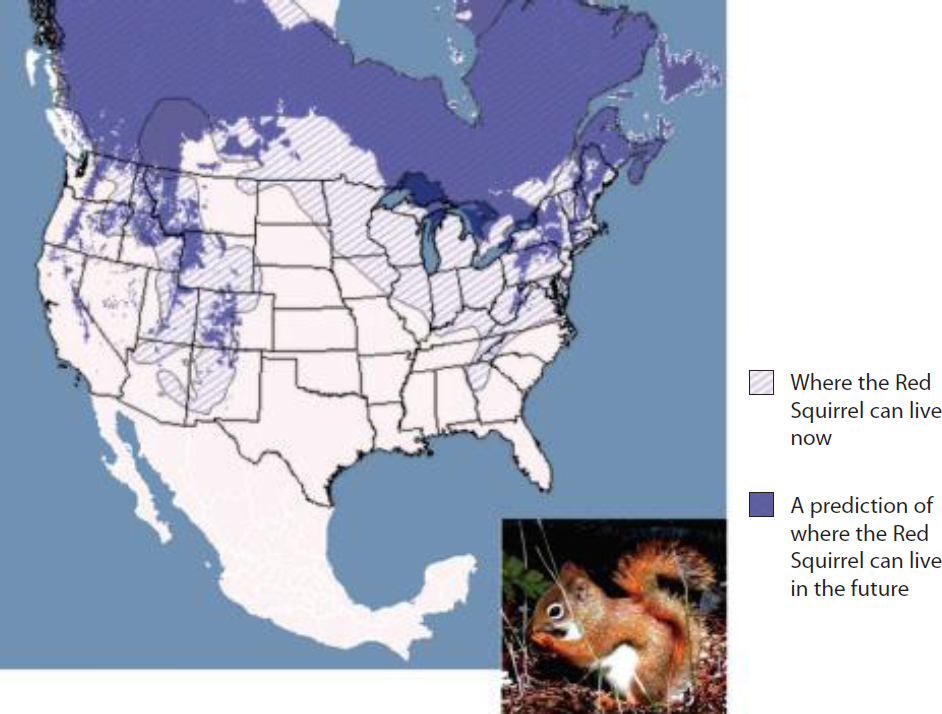
SOURCE: Songer et al. (2013). Reprinted with permission.
If the teacher is using this task for instruction and/or to assess where students are, she can opt to give the students access to a tutorial that teaches about how to develop predictions. This feature of the program prompts students as to what is needed and records their responses in a database that teachers and students can use.
The teacher can choose whether or not to allow students access to the pop-up text that describes what is meant by a claim or by evidence. If the students have already spent time learning about how to make and support a claim, the teacher can choose not to give them access to these supports and use their responses to develop unit or course grades, for example.
Table 4-1 shows the rubric used to code student responses to the question “Will climate change affect where the red squirrel can live in the future?” Table 4-2 shows five sample student responses. Teachers can use this display to quickly assess the range of responses in their class and make decisions about future instruction based on those responses.
TABLE 4-1 Scoring Rubric for Red Squirrel Prediction
|
Level 5 Demonstration of a complete knowledge product that effectively incorporates relevant scientific terminology. Elaboration: Appropriate DCI and CC are used in the explanation/prediction, which are detailed/elaborated. The explanation/prediction includes a claim supported by relevant evidence along with appropriate reasoning that links the claim and evidence. AND the product effectively incorporates relevant scientific terminology. Level 4 Demonstration of a complete knowledge product but lacking effective incorporation of relevant scientific terminology. Elaboration: Appropriate DCI and CC are used in the explanation/prediction, which are detailed/elaborated. The explanation/prediction includes a claim supported by relevant evidence along with appropriate reasoning that links the claim and evidence. AND the product does not incorporate any relevant scientific terminology, or uses only some of the relevant scientific terminology. Level 3 Demonstration of a partially complete knowledge product that is appropriately elaborated upon and effectively incorporates some relevant scientific terminology. Elaboration: Appropriate DCI and/or CC are used in the explanation/prediction, which are detailed/elaborated. The explanation/prediction is partially complete as one of the three parts of the explanation (claim, reasoning, evidence) is missing or not explicitly stated. AND the product effectively incorporates some relevant scientific terminology. Level 2 Demonstration of a partially complete knowledge product that lacks elaboration and does not incorporate relevant scientific terminology. Elaboration: Appropriate DCI and/or CC are used in the explanation/prediction, which are not adequately detailed/elaborated. The explanation/prediction is partially complete as two of the three parts of the explanation (claim, reasoning, evidence) are missing or not explicitly stated. AND the product does not effectively incorporate relevant scientific terminology. Level 1 Demonstration of an incomplete knowledge product that lacks elaboration and does not incorporate relevant scientific terminology. Elaboration: Only uses appropriate DCI, which is not adequately detailed/elaborated. AND the product does not effectively incorporate relevant scientific terminology. Level 0 Demonstration of an inaccurate knowledge product. Elaboration: Inappropriate DCI or scientifically inaccurate use of the DCI. |
NOTE: CC = crosscutting concept; DCI = disciplinary core idea.
SOURCE: Songer et al. (2013). Reprinted with permission.
TABLE 4-2 Sample Student Responses
| Level | Response | Characteristics of Response |
|---|---|---|
| 0 | No, because the red squirrel lives in hot and cold areas so if the temperature rises, the red squirrel could still live in warm areas so I don’t think climate change. |
|
| 1 | Yes, because the temperature can be too hot or too cold for it. |
|
| 2 | Yes, the red squirrel will have to move because of climate change. They will have to move farther north because they will not like it where they are found now. |
|
| 3 | Yes, climate change will affect the red squirrels in the future. The red squirrel will have to migrate North mostly into Canada because it will be hot in America. This is shown in the map in the purple color. |
|
| 4 | Yes, it will. In the map you can see that the area where the red squirrel can live in the future is in the North where the climate is colder. If the amount of carbon dioxide in the air increases, so will the temperature. If the temperature rises where the red squirrel may live, that place might not have suitable habitat for it anymore. |
|
| 5 | Yes, climate change will affect where the red squirrel can live. Scientists are predicting that the red squirrel will have to move north because if CO2 emissions increase, there will be more carbon dioxide in the atmosphere and the greenhouse effect will cause the temperatures to rise. This will force the squirrel to migrate to regions where the temperature is cool enough for it to survive and get the food that it needs. This is what we can see in the map where the future areas have moved up to Canada. |
|
SOURCE: Songer et al. (2013). Reprinted with permission.
Presenting this task using interactive computer technology has several advantages. It makes it possible to conveniently present data from several sources to the students. The software also makes summary information about the quality and range of student responses continuously available to teachers, who can then adapt their instruction to quickly address students’ misunderstandings or gaps in understanding. The software also makes it easy to customize the support and resources the students have access to.
The computer models make these tasks easier for a teacher to use, but the most important aspects of these tasks can be done without them. Like other tasks we’ve looked at, these assessment tasks provide students with information they can use to construct evidence-based explanations or predictions about the phenomenon, even if the data are not provided on a computer and it is not possible to work with it interactively.
These assessment tasks provide students with information they can use to construct evidence-based explanations or predictions about the phenomenon.
With both this and the “Diversity in the Schoolyard” example from Chapter 2, it is easy to see how a particular task structure can be used for multiple purposes: to instruct, to check student progress and see what supports are needed, or to make summative judgments about what students have learned. The tasks vary in terms of what the students have access to as they work through them and how much guidance they are receiving. The teacher adapts the prompts her students receive about the characteristics of a scientific explanation, where to look for evidence, how to approach a task, or when they have taken a wrong turn. These variations in the task are based on students’ proficiency levels and the teacher’s expectations about what students can accomplish without assistance. The teacher uses these results both to shape instruction to help students with areas that are difficult as well as to collect summative evidence at the end of the unit.
EXAMPLE 6 Movement of Water
Level Middle school
Assesses PRACTICES—Modeling, constructing examples
CROSSCUTTING CONCEPTS—Systems and system models
DISCIPLINARY CORE IDEAS—The roles of water in Earth’s surface processes [ESS2.C]
In this example the teacher uses a simple technology to assess students’ understanding while a discussion is going on and then uses the results to modify her next steps to address areas students need to work on.
In this example, the students work through an activity and then talk about it in a way that seems like a natural next step in the unit. In this case, though, the teacher has deliberately prepared for the discussion so that she can use it to collect information about their learning. The task is a class discussion that is used for formative assessment purposes as part of a middle school curriculum on Earth Systems. In the course of the unit, students have investigated weathering, erosion, and deposition, and they are learning about:
- a core disciplinary idea: how the properties and movement of water shape Earth’s surface and affect its systems;
- a crosscutting concept: systems and system models (models of geosphere-hydrosphere interactions); and
- the practice of developing an explanation based on evidence.
Before the day of this discussion, the students have already built physical models of water flowing through a landscape using stream tables (models of stream flows set up in large boxes filled with sedimentary material and tilted so that water can flow through). They have developed predictions about how water will move sediment and how that process affects the deposition of surface and subsurface materials.
At this point in the unit, the teacher wants to help students make sense of what they have learned and to check their understanding of the process of deposition. She uses a projection screen to show the students the two photographs in Figure 4-3.

SOURCES: NASA/GSFC/JPL/LaRC, MISR Science Team (2013) and Los Angeles County Museum of Art (2013).
She then presents multiple-choice questions for the students to answer using their clickers, such as this one:
The green areas marked above show the place where a river flows into an ocean. Why does this river look like a triangle (or fan) where it flows into the ocean? Be prepared to explain your response.
- Sediment is settling there as the land becomes flatter.
- The water can flow all over the place just before it meets the ocean.
- The river is transporting sediment to the ocean.
- Finer sediments suspended in the water are being deposited there.
The teacher uses clicker technology to collect individual student responses to the questions. This technology (also known as a classroom response system) allows students to use handheld clickers to respond to questions. The responses are gathered by a central receiver and immediately tallied for the teacher—or the whole class—to see. The teacher then uses these responses to decide what students need next. For example, she might set up small-group discussions that address misunderstandings, give certain students supplementary activities, or address a widely shared misunderstanding with the whole group.
This is a fairly straightforward activity—one that could be done without the technology (although the teacher would not have automatically generated tallies of the results). For example, students could raise their hands to signal which answer they choose, or they could mark their selection on a slip of paper. Either way, the teacher can prepare in advance to use this simple activity in a very targeted way.
In this case, the questions have been tested in classrooms so the response choices offered reflect common student misunderstandings. The students’ responses give the teacher information about what proportion of the class holds any of these common misunderstandings; the teacher also sees how individual students respond. If you develop a similar assessment, you and your colleagues can collect evidence about areas students struggle with and build that knowledge into the design of the task and the questions you use in the discussion.
Working in pairs or small groups, students discuss the reasoning that led them to their answers. The teacher helps get each group started by asking them to think about why someone might select each of the options, implying that any of them could be a reasonable response. The whole class reconvenes and the groups offer explanations for their choices to the whole class. The teacher encourages students to compare their own reasoning to that of others (the unit provides suggested discussion strategies). Then the students vote again, using their clickers.
Rather than highlighting who got the questions right and who got them wrong or placing students into ability groups, you are using the evidence you’ve collected about the class as a whole to structure a responsive lesson.
The responses help the teacher see which students are still having difficulties. The program includes a set of “contingent activities” teachers can use to improve the students’ understanding. Each of these contingent activities focuses on a particular learning objective, such as interpreting models, constructing explanations, or making predictions. So, for example, students who are having difficulty with the sample question might work independently on an activity in which they watch an animation of deposition and then make a prediction about a pattern they might expect to find at the mouth of a river where sediment is being deposited.
An activity like this can allow you to use your students’ responses to strategic questions to get them engaged in a back and forth about the possible answers and naïve conceptions. Rather than highlighting who got the questions right and who got them wrong or placing students into ability groups, you are using the evidence you’ve collected about the class as a whole to structure a responsive lesson.
Key Idea
Instructional activities can be adapted for different assessment purposes. A learning activity might be used to collect specific information about students’ progress—which the teacher uses to shape instruction. With changes, such as limiting the resources and supports students have access to, it could later be used to collect evidence of how well students have mastered learning goals.
TAKING ADVANTAGE OF TECHNOLOGY
“Movement of Water” uses clicker technology that allows students to register their responses to multiple-choice questions instantly, and it likewise allows the teacher to see tallies of those responses immediately. Even if you don’t have clicker technology, however, collecting fast responses to questions that are planned ahead of time to reflect common misconceptions can help you identify students who need more time with a concept or activity, or it can give you a sense of how to structure small-group discussions. For example, you might tally your students’ responses on a white board if you don’t have clicker technology. The same idea holds for other technologies as well. You may have access to sophisticated technology—or you may be able to take ideas from it that you can use in other ways to collect information without purchasing expensive software.
New technologically advanced tools, specifically designed to support instruction and assessment, are available every year, and they have a lot to offer. Sophisticated technology may make it possible to measure types of learning that are very difficult to measure in other ways. Computer simulations can give students access to digital versions of experiences that would otherwise be out of reach: for instance, experiments that involve expensive or dangerous materials or specialized equipment, or ones that would need to be carried out in particular settings or conditions not available in a school setting. They can allow students to carry out lengthy investigations in a compressed time frame. This is a capability that may be worth an investment because it allows students to engage in practices that wouldn’t be possible without it.
Other technology can make it easier to collect, record, and analyze data. Technology can make it possible for students to respond to assessment tasks in different ways that may be as easy to score as multiple-choice tasks but provide more information. For example, students might be able to indicate how they would classify something by dragging an image into a particular location or by highlighting part of an image; in another case, they might indicate which part of a model is incorrect by marking it with an X. It’s important to remember that while these tools can be valuable and make many tasks easier or more efficient, they may not be necessary. A task could be constructed to allow students to indicate classification or to identify components of a model without expensive technology, for example.
In this section we explore “Ecosystems,” an example of a sophisticated, interactive science program. Our focus is on the ways the designers used the technology to collect information as well as on how you might apply those approaches whether or not you have similar technology.
EXAMPLE 7 Ecosystems
Level Middle school
Assesses PRACTICES—Planning and carrying out investigations and interpreting patterns
CROSSCUTTING CONCEPTS—Systems and system models; Patterns
DISCIPLINARY CORE IDEAS—Ecosystems: Interactions, energy, and dynamics [LS2]
This is another example that illustrates how technology can enhance an assessment—by making it easy for students to interact with different kinds of material and for the teacher to customize the activities according to her needs. Many of the ideas could be applied even without the technology.
“Ecosystems” is a set of simulation-based modules that middle school students do as part of a curriculum unit on ecosystem dynamics. The modules let students explore representations of particular ecosystems, such as a mountain lake or grassland. The students investigate the roles of different species in a habitat, the
relationships among them, and the effects of these interactions on the population levels of each. The instruction is aimed at:
- a core idea: the features that are common to all ecosystems;
- a crosscutting concept: systems; and
- several practices: building and using models, planning and conducting investigations (by manipulating the system elements), and interpreting patterns.
In the course of the unit, the students study what a food web is and how it reflects the flow of matter and energy in the ecosystem. The program includes tasks that can be used for assessment: the students complete them as they get to the appropriate point in their learning. It is difficult to demonstrate all the features of a simulation-based activity in a printed book, but Figure 4-4 gives an idea of how the activity works. It is a screenshot that shows part of a simulated mountain lake environment and the options students would have when it is on their screen. Students observe animations that show how the organisms in this lake (such as algae, shrimp, and trout) interact.
A key feature of the program is that it responds frequently to what the students do. For example, as shown in Figure 4-4, the program prompts the students to draw directly on the screen to represent the way they think the food web would operate in this lake ecosytem. If a student draws an arrow that links a food
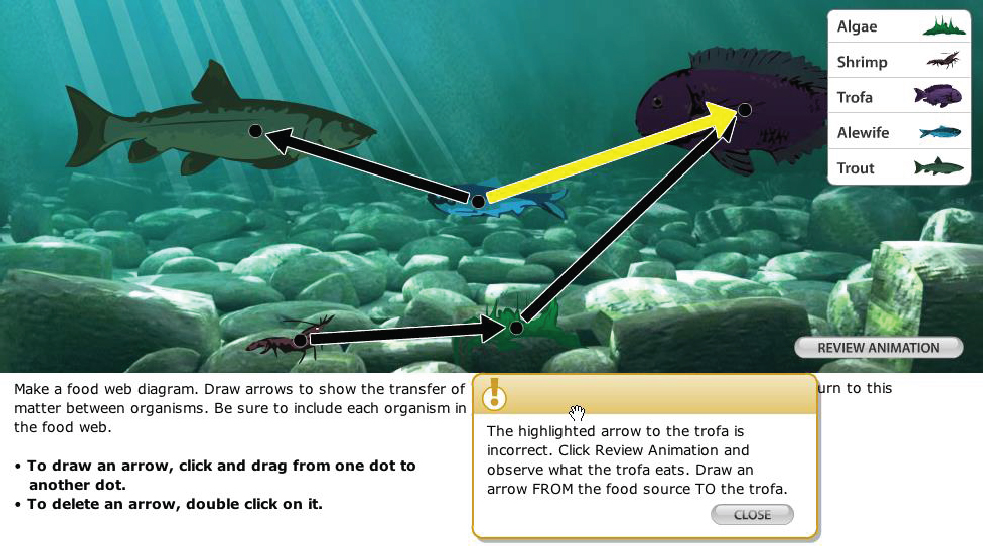
SOURCE: Quellmalz et al. (2012, fig. 2, p. 372). Reprinted with permission from John Wiley & Sons, Inc.
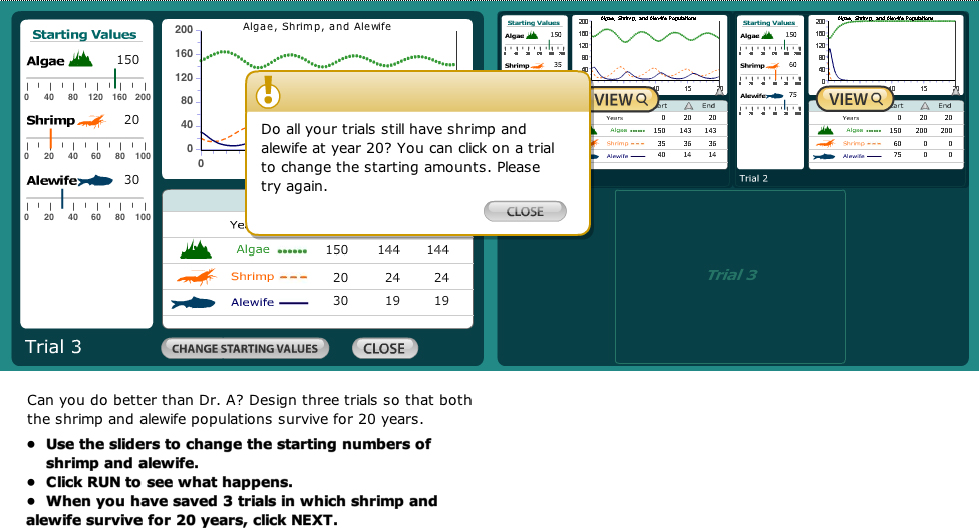
SOURCE: SimScientists Calipers II project (2013). Reprinted with permission.
consumer to the wrong source of matter and energy, a feedback box coaches the student to watch the animation more closely. This is formative feedback that gives students clear direction.
Later in the same module students investigate what happens when the organism populations are varied. As Figure 4-5 shows, the program prompts the students to set different relative population levels for the organisms in the ecosystem at the beginning of a defined time interval. The interactive simulation allows students to conduct multiple trials to see how things change in the ecosystem if there are more shrimp relative to algae levels at the start, for example, or fewer trout compared to alewife.
The students are prompted to draw conclusions about the factors that make an ecosystem healthy and balanced from the data they collect. The program prompts them to develop models of ecosystems and to evaluate how well each represents what the data are showing and the conclusions they have drawn. As students progress through the modules, the program frequently asks them to describe and explain what they have observed and to draw conclusions.
Another key feature of the program is that the teacher can customize these activities to meet her goals. If students are still working to build their understanding, the program can give them immediate feedback. It can also provide a graduated sequence of coaching to help students work through the challenges. Figure 4-6 shows a feedback box for this set of activities, which notifies the student that something doesn’t make sense and prompts him or her to correct it. The text at the bottom of the screen lets the student know when to go on to
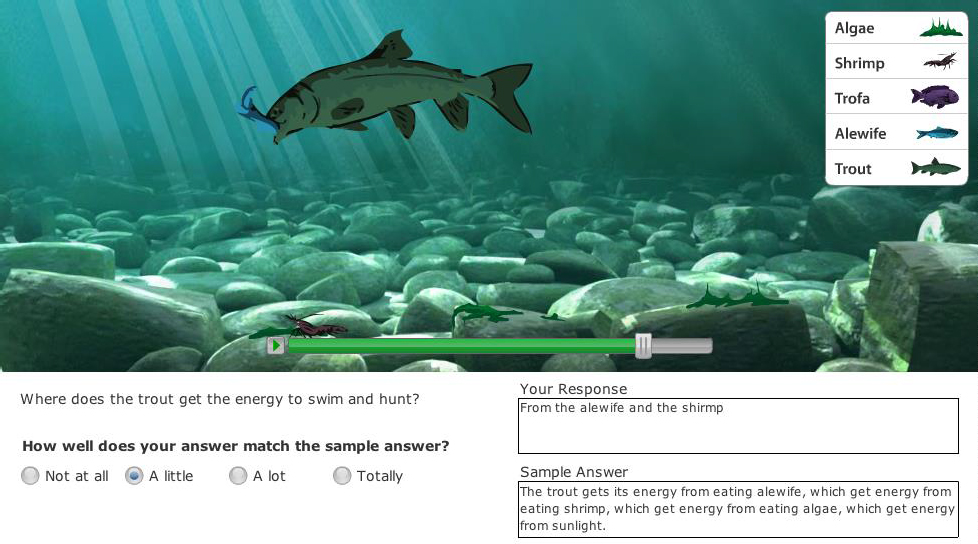
SOURCE: SimScientists Calipers II project (2013). Reprinted with permission.
the next task, which is analyzing the population graphs and designing three separate trials that will each result in survival for two of the organisms.
Figure 4-6 shows another way the program can provide formative feedback. The student is asked to respond to a question and then is shown a sample answer for comparison. Questions guide the student to think about how he or she might come up with a better response to this sort of question.
When the students are ready, the teacher can set the program to provide less guidance so that she can use the task as a summative assessment. Figures 4-7 and 4-8 show modules from the same program that are used for summative assessment. Students are asked to investigate ways to restore an ecosystem they have not studied—an Australian grassland that has been affected by a significant fire. Neither feedback nor coaching is provided.
Students investigate the animals, birds, insects, and grass by observing animations of their interactions. Based on the interactions they have observed, they draw a food web representing a model of the flow of energy and matter throughout the ecosystem (see Figure 4-7). Next, the program asks them to set up trials similar to the ones done in the formative module about the lake. They can alter the starting populations of crickets and lizards and experiment until they can find three different ratios that will result in both of these species surviving for 20 years. The program also prompts the students to explain their interpretations, draw conclusions, and so forth, but without hints. In a culminating task, students present their findings about the grasslands ecosystem.
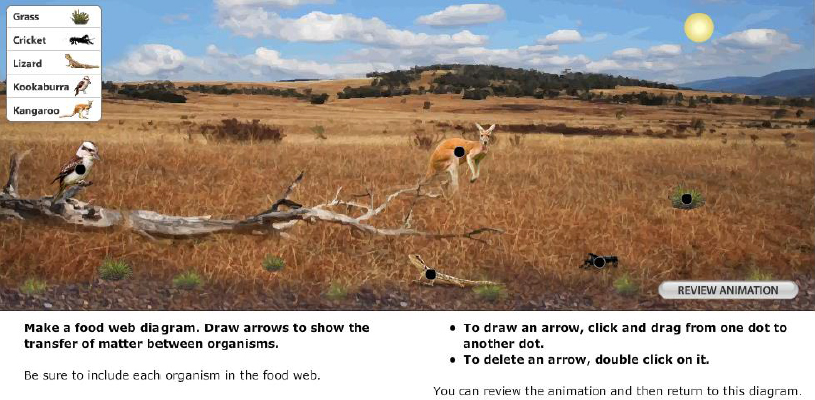
SOURCE: SimScientists Calipers II project (2013). Reprinted with permission.
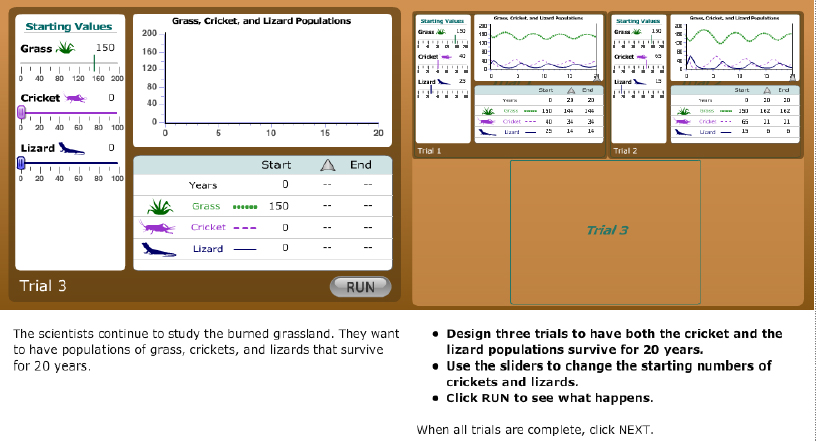
SOURCE: SimScientists Calipers II project (2013). Reprinted with permission.
These assessment modules are designed to address common difficulties students have in reasoning about the components of an ecosystem and the way species behave, as well as their errors in the use of science practices. The simulation generates reports for students about their progress, and teachers can view progress reports for individual students as well as class-level reports. The reports indicate the level of additional aid students may need and can help the teacher group the students to effectively address their areas of difficulty. The program also includes tailored, follow-on reflection activities.
The simulation technology is engaging for students and fun to work with, but those benefits alone might not make it worthwhile. This program engages students in three-dimensional learning through challenging scientific reasoning tasks. Students learn about model-based reasoning in the context of instruction about how ecosystems are structured and how they behave. The task that presents a new ecosystem tests their ability to apply the concepts they learned in studying one ecosystem as they describe the dynamics they observe in a different one they haven’t studied.
A commercially available assessment might use simulation without having tasks that measure three-dimensional understanding. Because new software and other technology can be expensive, it’s important to be a critical consumer. Some “new” assessments are really the same old types of assessments in a new package, so they might not be worth the added expense. And there may be new applications for devices and programs you already have access to.
You may be able to use certain features of new software to take advantage of the rich context they offer, but you could modify some or all of the tasks, or substitute other activities you devise, to better assess the development of three-dimensional learning over time.
WHAT DO THESE EXAMPLES SHOW US?
“Climate Change” is an example of how a teacher can use an activity for a variety of purposes. The same activity could be used to introduce students to new ideas and practices as well as to guide them in using resources and tools to direct their own learning. It might be adapted to collect information about students’ misconceptions so the teacher can respond with instructional interventions right away, or it might be structured as a summative assessment that produces scores that inform parents or others about what students have mastered. “Movement of Water”
shows how a fairly simple activity can yield a lot of information if it is designed strategically to provide information a teacher needs at a particular point in instruction. “Ecosystems” is an example of an assessment that uses sophisticated technology to make it easier for a teacher to assess three-dimensional learning that takes place over time. Understanding how this example works can help you as an educator identify assessment technology that is worth a potentially high cost and also see how you might accomplish in other ways some of what the technology makes possible.
CHAPTER HIGHLIGHTS
- Even if your district and state have not adopted new standards that reflect the 2012 framework, or they are not yet revamping their assessments, adapting your own assessments will be a critical aspect of modifying your instruction to engage your students in doing science for themselves and learning in a three-dimensional way.
- The examples in this chapter illustrate more ways to work new assessment ideas into your instruction, adapting activities you already use so they can give you evidence about your students’ learning.
- New technology may be an important asset as you make changes, but you can begin by using resources you already have.




















